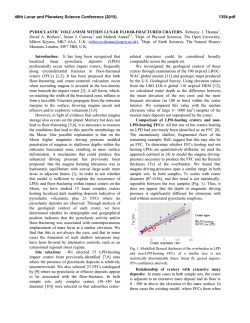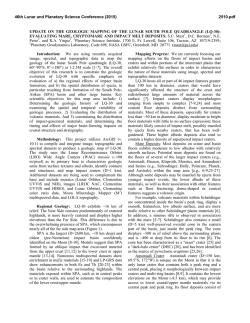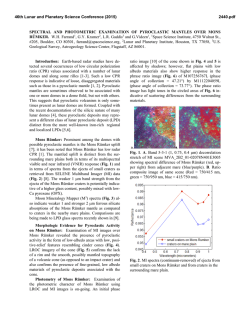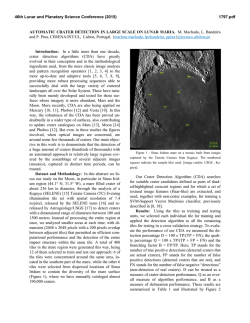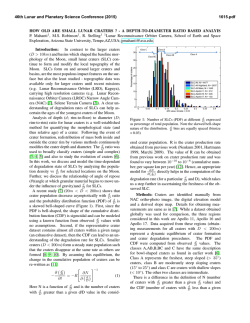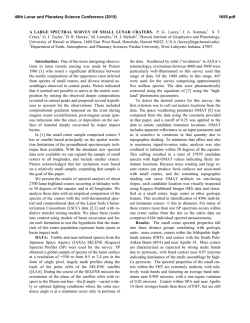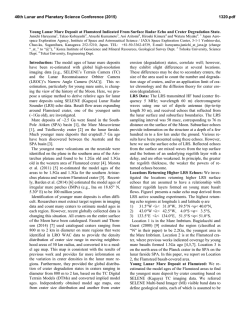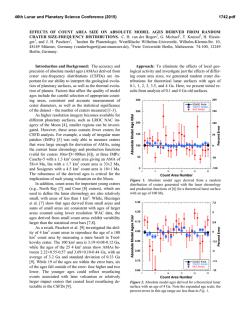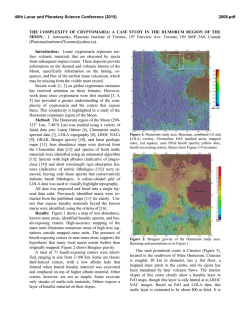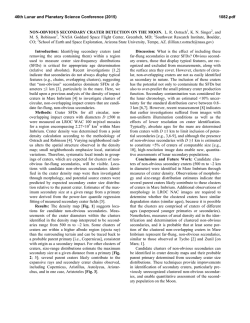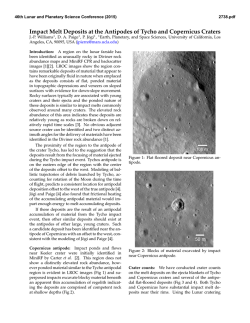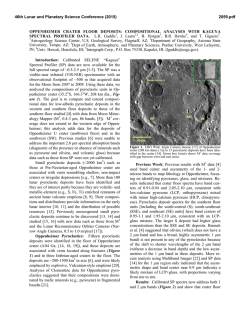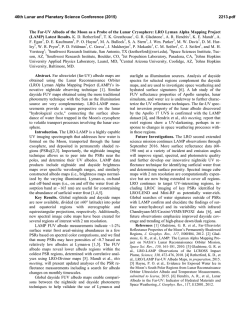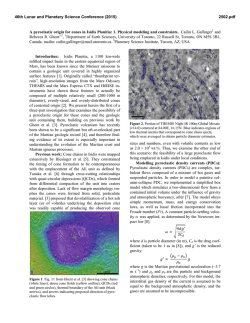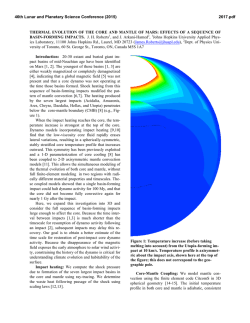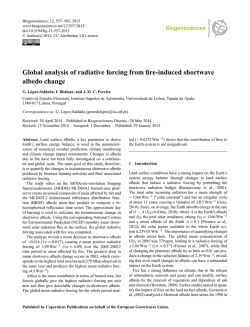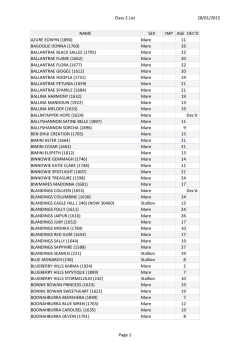
2386
46th Lunar and Planetary Science Conference (2015) 2386.pdf EXCAVATION DEPTHS OF SMALL DIAMETER CRATERS ON A PYROCLASTIC DEPOSIT NEAR NORTHERN RIMAE BODE, THE MOON. A. E. Huff1, J. J. Hagerty2, J. A. Skinner Jr.2, C. M. Fortezzo2, T. A. Gaither2, and L. R. Gaddis2. 1Northern Arizona University, School of Earth Sciences and Environmental Sustainability, Flagstaff, AZ 86001 ([email protected]); 2USGS, Astrogeology Science Center, Flagstaff, AZ 86001. Introduction: Geologic mapping and analysis of planetary surfaces is constantly evolving and researchers are generating new ways of interpreting and mapping the extensive influx of recently available lunar data. The Copernicus quadrangle has been an area of interest on the Moon because the region contains examples of major surface processes (e.g., volcanism, impact cratering, tectonic modification), as well as materials representative of all lunar epochs[1]. To extract as much scientific information as possible from the Copernicus regions, we are combining traditional geomorphological mapping techniques with compositional data derived from remote sensing observations of the lunar surface. To support this approach, this study mapped the distribution of lunar pyroclastic deposits, possible source vents, and craters within the quad to determine the areal extent, foci, and volume of pyroclastic materials as a precursor for future compositional investigations. Data Sets: We used data from the Lunar Reconnaissance Orbiter Camera Wide Angle Camera (LROC WAC), the Kaguya Terrain Camera (TC), Visible Camera and TiO2 global map, the Clementine Ultraviolet Vis-ible Spectrometer (UVVIS), and the Clementine Global Iron, Titanium, and Optical Maturity maps to map features in ArcGIS. Background: Contrary to terrestrial pyroclastic deposits, lunar pyroclastic deposits (LPDs) are typically dark basaltic glass deposits that mantle the underlying substrate [2]. LPDs can overlie craters, mare, highlands, and mare/highland boundaries [2]. Similar, low albedos often obscure the boundary between LPDs and mare deposits, therefore identification depends on textural differences between the flatter, smoother mare and rougher, irregular LPDs. The surface texture of LPDs is accredited to the Strombolian eruptive process producing pyroclastic glass beads [2]. Driven by volatile exsolution, magma ascended rapidly through dunite-lined conduits and was erupted onto the lunar surface thus allowing the magma to essentially remain unaltered during its ascent and as such the glasses represent windows into the lunar mantle [3 - 5]. The magmas that produced the LPDs are the result of partially melting source regions within the lunar mantle. Once it is known how much partial melting the magma underwent, the composition of the source region can be mathematically derived, thus providing critical information about the composition of the lunar mantle [3 - 5]. Source Vents: Identifying source vents was a primary objective for this project, and their locations were applied to understanding pyroclastic deposit distibutions within the region. If the thickness of LPDs can be correlated with source vent locations, then the eruption dynamics can be derived, which in turn has implications for understanding characteristics of the source region that produced the pyroclastic magmas [3 – 5]. Previously identified LPDs in the Copernicus quadrangle (i.e., Rimae Bode and West Sulpicius Gallus) were used to compare newly mapped deposits within the quad (via textural and spectral characteristics). To locate potential pyroclastic deposits, 534 possible source vents throughout the quad were identified at 1:250,000 scale using the LROC WAC mosaic. Possible vent sources were identified by their linear to curvilinear nature and locations correlative to rough and irregular low albedo deposits. LPD Mapping: Morphologic variations within the boundaries of the LPDs were mapped in an effort to determine the cause of the morphologic differences. Three different units were mapped based on albedo and texture: very low albedo materials as dark mantle (dm), relatively low albedo materials as intermediate mantle (im), and plains domes (pd) where there were occurrences of annular positive relief. Mapping began within Rimae Bode and West Sulpicius Gallus with additional mapping northeast of Montes Carpatus and within the Hortensius region west of Copernicus crater. The Hortensius region contains volcanic domes which were also mapped as part of this project, due to the abundance of volcanic features in that region. These postulated LPDs were mapped at an average scale of 1:250,000 based on data from the Kaguya TC, Visible Camera, and TiO2 global map. Cross referencing with Clementine UVVIS and the global iron, titanium, and optical maturity data sets allowed for consistency with observed patterns from known LPDs in Rimae Bode and West Sulpicius Gallus (Figure 1). The dark mantle deposits were studied first to confirm that they are in fact LPDs (via albedo and composition). In order to do this, methods were generated to compare potential pyroclastics to known LPDs using standardized data from the two previously identified LPDs in Copernicus quadrangle. Crater Analysis: Two types of craters were distinguished at 1:10,000 on the data layer from the 46th Lunar and Planetary Science Conference (2015) Kaguya TC. Penetrating craters (P) with relatively high albedo around the rims (compared to surrounding terrain) were interpreted to have penetrated to the underlying rock unit. NonPenetrating craters (NP), with no change or with darker albedo around the rims, were thought to have shallowly impacted the pyroclastics only (i.e., they did not penetrate the deposit). Calculations from the Crater Helper tool in ArcGIS generated statistics on excavation depth [6]. Crater Helper has a method to take three points along a rim and fit a circle around the crater rim and calculate an accurate rim diameter. Using the diameter from Crater Helper, calculations were done to find the depth of excavation [7]. Craters within Rimae Bode were identified, mapped, and measured to calculate depth to diameter ratios. 606 craters were measured in Rimae Bode and of those, 313 were penetrating craters (Figure 1, Table 1) ranging in size from ~35 - 600 m in diameter with the highest concentration of penetrating craters being from 50 - 75 m with a mean excavation depth of 5.3 m. These depths could be used to estimate thicknesses of the entire Rimae Bode deposit. Discussion and Future Work: Further analysis of impact craters and their ejecta would lead to a better grasp on how deep the craters impacted and how much of the substrate was actually excavated. From that, the mean excavation depth will be used to find the mean depth of pyroclastics based on the amount of underlying rock that was excavated. By estimating LPD thicknesses, a source vent locatio n can be constrained. Such estimates will be extended to other 2386.pdf possible vent locations by replicating the pyroclastic mapping and Crater Helper process. The morphologic characteristics will then be combined with compositional information from each LPD within the quad to obtain a deeper understanding of the pyroclastic eruption dynamics and subsequently the lunar mantle source region for the magmas. Table 1. Crater diameters, number, and range and mean values for excavating depths. Diameter (m) N Range (m) 𝐱 (𝐦) <50 39 3.13 – 4.19 3.8 50 – 75 139 4.20 – 6.29 5.3 75 – 100 80 7.39 – 8.38 7.2 >100 55 8.46 – 50.3 12.96 References: [1] Shoemaker E. M. and Hackman R. J. (1962) Academic Press, p. 289-300. [2] Gaddis L. R. et al. (2003) Icaraus, 161, 262-280. [3] Hagerty J. J. et al. (2009) JGR, 114, E04002. [4] Hagerty J. J. et al. (2006) Geochim. Cosmochim. Acta, 70, 3457-3476. [5] Wilson L. and J. W. Head III (2003) Geophys. Res. Lett., 30, 1605. [6] Hare T. M. Skinner J. A. Fortezzo C. M. Tanaka K. L. and Nava R. A. (2012) Lunar Planet. Sci. Conf., 43, Abstract #2871. [7] Melosh J. (1989) Impact Cratering: A Geologic Process, Oxford University Press. Acknowledgements: This work was supported by NASA through the Planetary Geology and Geophysics program via grant NNH12AU82I (PI J. Hagerty) and by the Planetary Geology and Geophysics Undergraduate Research Program (PGGURP PI, A. Huff). Figure 1. Pyroclastic units and measured craters in northern Rimae Bode (cen. 12 °N, -4 °E). Western, smoother, mare deposits with large wrinkle ridges grade into rough, knobby highlands to the east. Both mare and highlands deposits are overlain by a dark mantle (dm, tan) and an intermediate mantle (im, orange). Craters shown in color where penetrating, and shown in black where non-penetrating. See Table 1 for the range and mean values of excavation. Background image is a portion of the LROC WAC stereo-derived shaded relief (100 m/pixel). North is towards the top of the figure.
© Copyright 2025
